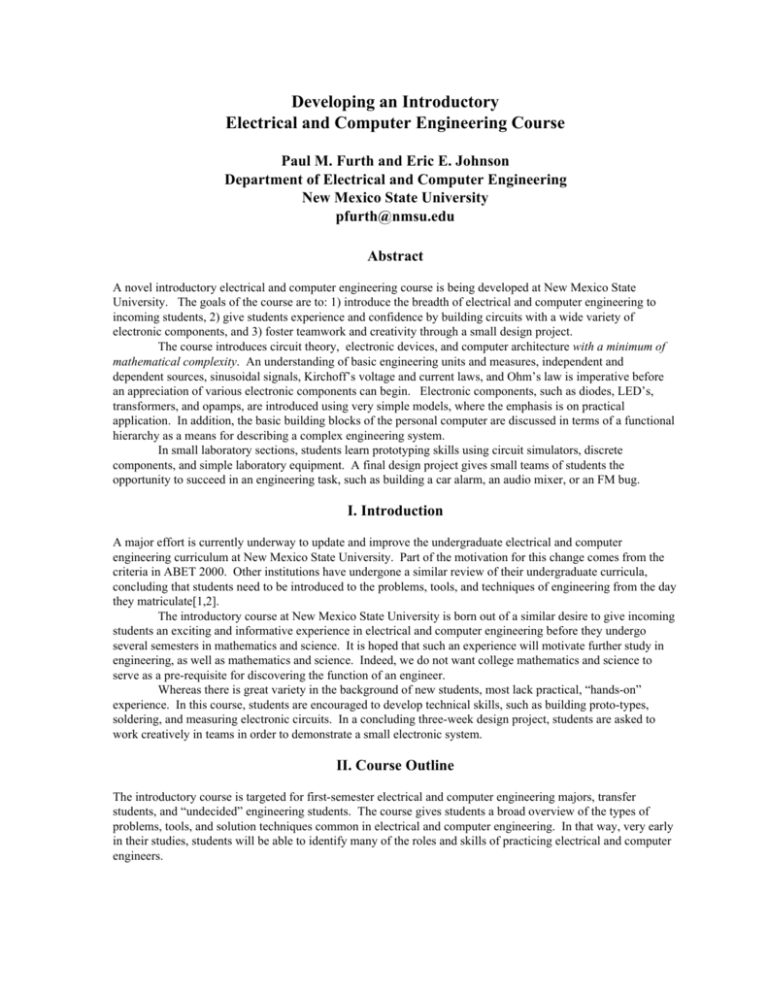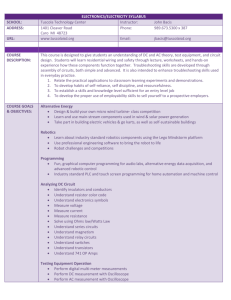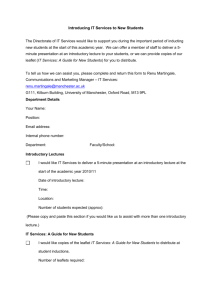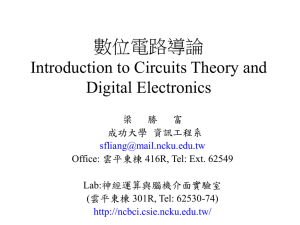as a PDF
advertisement

Developing an Introductory Electrical and Computer Engineering Course Paul M. Furth and Eric E. Johnson Department of Electrical and Computer Engineering New Mexico State University pfurth@nmsu.edu Abstract A novel introductory electrical and computer engineering course is being developed at New Mexico State University. The goals of the course are to: 1) introduce the breadth of electrical and computer engineering to incoming students, 2) give students experience and confidence by building circuits with a wide variety of electronic components, and 3) foster teamwork and creativity through a small design project. The course introduces circuit theory, electronic devices, and computer architecture with a minimum of mathematical complexity. An understanding of basic engineering units and measures, independent and dependent sources, sinusoidal signals, Kirchoff’s voltage and current laws, and Ohm’s law is imperative before an appreciation of various electronic components can begin. Electronic components, such as diodes, LED’s, transformers, and opamps, are introduced using very simple models, where the emphasis is on practical application. In addition, the basic building blocks of the personal computer are discussed in terms of a functional hierarchy as a means for describing a complex engineering system. In small laboratory sections, students learn prototyping skills using circuit simulators, discrete components, and simple laboratory equipment. A final design project gives small teams of students the opportunity to succeed in an engineering task, such as building a car alarm, an audio mixer, or an FM bug. I. Introduction A major effort is currently underway to update and improve the undergraduate electrical and computer engineering curriculum at New Mexico State University. Part of the motivation for this change comes from the criteria in ABET 2000. Other institutions have undergone a similar review of their undergraduate curricula, concluding that students need to be introduced to the problems, tools, and techniques of engineering from the day they matriculate[1,2]. The introductory course at New Mexico State University is born out of a similar desire to give incoming students an exciting and informative experience in electrical and computer engineering before they undergo several semesters in mathematics and science. It is hoped that such an experience will motivate further study in engineering, as well as mathematics and science. Indeed, we do not want college mathematics and science to serve as a pre-requisite for discovering the function of an engineer. Whereas there is great variety in the background of new students, most lack practical, “hands-on” experience. In this course, students are encouraged to develop technical skills, such as building proto-types, soldering, and measuring electronic circuits. In a concluding three-week design project, students are asked to work creatively in teams in order to demonstrate a small electronic system. II. Course Outline The introductory course is targeted for first-semester electrical and computer engineering majors, transfer students, and “undecided” engineering students. The course gives students a broad overview of the types of problems, tools, and solution techniques common in electrical and computer engineering. In that way, very early in their studies, students will be able to identify many of the roles and skills of practicing electrical and computer engineers. The course is designed to have 3 hours of lecture and 3 hours of laboratory per week. The topics to be covered in a 4-credit one-semester course are outlined in Table 1. Some of these topics are most effectively addressed in lecture and others in lab. The use of senior-undergraduate or graduate teaching assistants in laboratories is necessary in order to maximize instructor-to-student and student-to-student interaction. Topic Overview of Electrical and Computer Engineering International System of Units Voltage, Current, and Power Circuit Elements - Resistance (Ohm’s Law) - Kirchoff’s Voltage and Current Laws - Independent and Dependent Sources Graphical SPICE Circuit Simulator Sinusoidal Signals Measuring Instruments and Proto-typing Skills - Digital Multi-meter - Oscilloscope - Soldering - Bread boarding Electronic Components - Diode as a Rectifier - Bipolar Transistor as a Current Amplifier - CMOS Transistors as Switches - Photo-Diode and Photo-Transistor for Communication Integrated Circuits - Operational Amplifier and Applications - CMOS Inverter and Simple Logic Gates Systems Approach to Problem Solving - Personal Computer as a Complex Engineering System - Personal Computer Building Blocks and Hierarchy Team Design Project - Design, Proto-type, and Demonstration - Written Report and Oral Presentation Table 1 Outline of introductory electrical and computer engineering course by topic. An overview of electrical and computer engineering will be given through examples of familiar engineered systems, such as automobiles, cellular phones, television, the Internet, and so on. Guests from diverse electrical and computer engineering disciplines will be invited to describe their responsibilities, day-to-day activities, and career goals in small interactive (laboratory) sessions. For the most part, the avenue through which students are introduced to electrical and computer engineering in this course is the analysis and design of electronic circuits. The course emphasizes a solid foundation in engineering units and measures, Ohm’s Law, and Kirchoff’s voltage and current laws. An understanding of independent and dependent sources and sinusoidal signals is needed before an appreciation of the variety of electronic components can develop. Electronic components, such as diodes, bipolar junction transistors, light-emitting diodes, and operational amplifiers, are introduced using simple mathematical models. Toward the end of the course, the personal computer is introduced as a complex engineering system. Requirements, trends, and costs of personal computers are first discussed. Subsequently, the basic building blocks of the personal computer are described in the form of a functional hierarchy. Laboratory computers will be opened up as part of this description. It is hoped that students will gain a working vocabulary in electronic hardware as a benefit of taking this course. At the beginning of the semester, the instructor assigns students in teams of two. The students work together on laboratory experiments and, most significantly, accomplishing a three-week final design project. Student teams are asked to choose from one of several options to design and construct a simple electronic system, such as an FM transmitter, an audio mixer, or a car alarm system. Each team will submit a written report and give an in-class presentation on their project. In this way, the course underscores written and oral communication as important engineering skills. The single software tool that students acquire during the course is a graphical version of SPICE, such as P-SPICE. The simulator will be used to demonstrate basic circuit theories, as well as the operation of electronic components. In addition, students are asked to check a subset of their homework solutions using the simulator. In a complementary course entitled “Computer-Aided Problem Solving,” students learn in detail the structure and syntax of a modern computer programming language, C/C++. They also learn how to apply engineering math tools, such as MATLAB, to solve real engineering problems. Students are encouraged to take both of these classes during their first year. Subsequent courses in the major are being designed to use these computer tools regularly so that students retain and improve their proficiency. III. Course Implementation The introductory electrical engineering course will be phased into the curriculum over a one-year period. In that time, it is hoped that funding and space for laboratories will become available. We are looking for support from industrial partners, as well as state and federal agencies. In the meantime, we have devised a short-term implementation that can cover every topic in the course outline, except experiments with an oscilloscope. We also describe experiments with the new course that are in progress during the 1996-97 academic year. III(a) The Short-Term Implementation Pre-existing computer laboratories will be used to demonstrate the graphical circuit simulator and to learn the basic building blocks of the personal computer. Students have access to these computers almost full-time, so that they can do assignments with the circuit simulator at their convenience. Similarly, basic soldering skills and circuit measurement techniques will be demonstrated in pre-existing electronics laboratories. Beyond that, students will be furnished with a basic electronics toolkit that is owned by the department. The contents of the toolkits are detailed in Table 2. Its total cost is less than $45. A single toolkit is shared among two teams of two students each. Thus, for a class size of 40 students, the approximate cost to the department is $450, which is less than the price of one modern oscilloscope. III(b) Experiments with the New Course A portion of this new curriculum has been adopted in experimental sections of a sophomore introductory circuits course during the 1996-97 academic year. The students were generally eager to buy, build, test, and modify two simple electronic projects, as part of the experimental curriculum. They worked in teams of two, submitting a single written report and giving an oral presentation at the end of the semester. In an informal mid-course evaluation of the Fall 1996 experimental section, 14 out of 36 students were very enthusiastic about the projects. Sample comments were: • "We see physically what each component looks like." • "We gain insight into how the components work." • "The projects help motivate us to learn electronics." On the other hand, four students gave somewhat negative, but realistic responses. Sample comments were: • "Projects add confusion, since we don't really understand how the components work and they are unfamiliar to us." • "Projects are a hassle!" The other 18 students did not respond. Nothing conclusive can be drawn from such a small sample. Quant. Vendor / Telephone Number Part Number Description 3-1/2 Digit LCD Multi meter 1 ea. Hosfelt Electronics 1-800-524-6464 9202 1 ea. `` SP23 1/15 ea. `` 46-127 Unit Cost Total Cost 16.95 16.95 Weller Marksman 25W Soldering Iron 9.95 9.95 Solder 60/40 .031” 6.95 0.46 1/3 ea. `` 46-130 Desoldering Braid 5ft. 0.1” 0.95 0.32 10 ft. `` 36-146 2 Conductor 22AWG Black/Red stranded wire 0.06 0.60 1 ea. Jameco Electronics 1-800-831-4242 99565 4 Piece Screwdriver set with 2 Pliers for Electronics 9.95 9.95 1 ea. Everything Rubbermaid 1330-264-7592 7710 Model 7710 Toolbox, 2nd 4.99 4.99 1/8 ea. Ace Hardware N/A 400 Grit Sandpaper 0.75 0.09 1/24 ea. `` N/A Package of Fine Steel Wool 0.95 0.04 1/8 ea. `` N/A Sponge 2.49 0.31 TOTAL COST $43.66 Table 2. Contents, pricing, and ordering information of a simple electronics toolkit. III(c) Long-term Implementation In the long-term, industrial and government sponsors will be needed to build and maintain an introductory electronics laboratory. Initially, we will seek laboratory power supplies, digital multi meters, and oscilloscopes. In the future, we hope to equip the laboratory with personal computers and such common consumer electronic devices as AM/FM radios, stereos, CD players, and car alarm systems. IV. Discussion and Conclusion An introductory course in electrical and computer engineering, with emphasis on electronic circuits, but without mathematical rigor, does not replace an introductory circuits class which incorporates calculus and complex numbers. Such a course is of benefit to non-majors preparing for the Fundamentals of Engineering Exam. A textbook and laboratory manual that we are considering for adoption for this course is Electrical Engineering Uncovered[3]. It is doubtful that a single textbook will cover all the topics of this class at a suitable level; thus, supplementary material may be needed. This paper has described a new introductory electrical and computer engineering course that is being developed at New Mexico State University. The concurrent goals of the course are to: 1) introduce the breadth of electrical and computer engineering to incoming students, 2) give students experience and confidence building circuits with a wide variety of electronic components, and 3) foster teamwork and creativity through a small design project. An outline of the course has been given, as well as details on short-term and long-term implementations. We are glad to receive input and share our results from other institutions developing a similar introductory course in electrical and computer engineering. References [1] Electrical and Computer Engineering at Carnegie Mellon - a New Curriculum, Dept. of Electrical and Computer Engineering, Carnegie Mellon University, Pittsburgh, PA, 1995. [2] Prados, John W., “Educating Engineers for the 21st Century,” in Systematic Engineering Education Reform: An Action Agenda, a workshop of the NSF Engineering Directorate, Arlington, VA, July, 1995. [3] White, Dick and Doering, Roger, Electrical Engineering Uncovered, Prentice Hall, 1997. Paul M. Furth received the B.A. from Grinnell College in 1984, the B.S. from the California Institute of Technology in 1985, and the M.S. and Ph.D. from Johns Hopkins University in 1992 and 1995, respectively. From 1985-1989 he worked as a project engineer for TRW Technar on airbag systems for automobiles. Currently, he is Assistant Professor of Electrical and Computer Engineering at New Mexico State University and Co-Director of the VLSI Laboratory. He teaches undergraduate courses in circuits, micro-electronics, analog circuit theory, and VLSI design. His research interests are in low-power analog computing systems.






